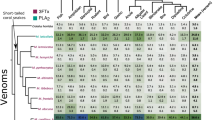Summary
Aconitine in a concentration of 10 μg/ml excites the pressoreceptors of the carotid sinus in cats. In single fibre preparations, first the period of discharge accompanying each systole becomes longer, later on a continuous discharge is observed. The modulation of the spike distance decreases with the increase of excitation. — At a concentration of 100 μg/ml, the receptors stop firing with the beginning of the systole and start to discharge again only when the pressure decreases during diastole. As an explanation, the receptors are thought to be subjected to a very strong depolarisation by the combination of aconitine-induced depolarisation and physiologically induced generator potential, so that repolarisation becomes impossible during the systolic period. — Occasionally, the activity of chemoreceptors from the carotid body was observed. They are more sensitive to aconitine than the pressoreceptors; their excitation induced by aconitine can be antagonized with calcium ions more readily than in pressoreceptors.
5–10 μg/kg aconitine intravenously in cats were sufficient to excite atrial receptors type A and B from both sides as well as ventricular receptors. The excitation is typical especially in atrial B-receptors.
From a comparison of the present work with the earlier investigations of Geilenkirchen the conclusion is drawn that the carotid pressure receptors play no essential role in the initial bradycardia and hypotension which follow administration of aconitine (Bezold-Jarisch-effect).
Zusammenfassung
Aconitin erregt in Konzentrationen von 10 μg/ml die Baroreceptoren des Carotis sinus bei Katzen; zuerst wird die synchron mit jeder Blutdruckwelle entstehende Impulssalve länger, später gehen die Salven ineinander über und es entsteht eine Dauerentladung. Der Impulsabstand wird anfangs durch die Blutdruckwelle noch deutlich moduliert, mit steigender mittlerer Impulsrate nimmt jedoch auch die Modulation ab. Bei einer Aconitinkonzentration von 100 μg/ml reißt die Dauerimpulsation mit Beginn jedes systolischen Blutdruckanstieges ab und beginnt erst wieder während des diastolischen Abfalls. Die Pausen werden als Lähmung des Receptors durch überkritische Depolarisation erklärt. — Chemoreceptoren aus dem Glomus caroticum werden bereits durch geringe Aconitinkonzentrationen erregt. Die Aconitinwirkung ist bei ihnen durch Calcium-Ionen besser antagonisierbar als bei Baroreceptoren.
5–10 μg/kg Aconitin erregen nach i.v. Injektion bei Katzen die Vorhofsreceptoren vom Typ A und B und ventrikuläre Receptoren. Der Erregungsverlauf ist bei B-Receptoren besonders typisch und weist nach Injektionen höherer Dosen ebenfalls Pausen während der vorher kontinuierlichen Dauerimpulsation auf, die sich wie bei den Baroreceptoren des Carotis sinus erklären lassen.
Der Vergleich der Befunde mit den früheren Untersuchungen von Geilenkirchen läßt den Schluß zu, daß an der initialen Blutdrucksenkung durch Aconitin (Bezold-Jarisch-Effekt) wohl kardiale Receptoren, nicht aber Pressoreceptoren aus dem Sinus caroticus beteiligt sind.
Similar content being viewed by others
Literatur
Aviado, D. M., R. G. Pontius, and C. F. Schmidt: The reflex respiratory and circulatory actions of veratridine on pulmonary, cardiac and carotid receptors. J. Pharmacol. exp. Ther. 97, 420–431 (1949).
Bronk, D. W., and G. Stella: Afferent impulses in the carotid sinus nerve. I. The relation of the discharge from single end organs to arterial blood pressure. J. cell. comp. Physiol. 1, 113–130 (1932).
Coleridge, H. M., J. C. G. Coleridge, and C. Kidd: Cardiac receptors in the dog, with particular reference to two types of afferent ending in the ventricular wall. J. Physiol. (Lond.) 174, 323–339 (1964).
Geilenkirchen, H.: Reflektorische Kreislaufwirkungen des Aconitins. Naunyn-Schmiedebergs Arch. exp. Path. Pharmak. 198, 152–157 (1940).
Heymans, C., and E. Neil: Reflexogenic areas of the cardiovascular system. London: Churchill 1958.
Jarisch, A.: Der Einfluß der Vagusausschaltung auf den Blutdruck. (Nachweis des Bezold-Effektes). Arch. Kreisl.-Forsch. 9, 1–10 (1941).
—— Detektorstoffe des Bezoldeffektes. Wien. klin. Wschr. 61, 551 (1949).
——, and Y. Zotterman: Impulse activity in the carotid sinus nerve following intracarotid injection of potassium chloride, veratrine, sodium citrate, adenosine triphosphate and α-dinitrophenol. Acta physiol. scand. 25, 195–211 (1952).
——, and Y. Zotterman: Depressor reflexes from the heart. Acta physiol. scand. 16, 31–51 (1949).
Katz, B.: Depolarization of sensory terminals and the initiation of impulses in the muscle spindle. J. Physiol. (Lond.) 111, 261–282 (1950).
Landgren, S.: On the excitation mechanism of the carotid baroreceptors. Acta physiol. scand. 26, 1–34 (1952).
Langrehr, D.: Entladungsmuster und allgemeine Reizbedingungen von Vorhofsrezeptoren bei Hund und Katze. Pflügers Arch. ges. Physiol. 271, 270–292 (1960).
—— Beziehungen zwischen Vorhofsreceptorenaktivitäten und Herzmechanik von Hund und Katze bei verschiedenen Kreislaufzuständen. Pflügers Arch. ges. Physiol. 271, 270–282 (1960).
Moissejeff, E.: Zur Kenntnis des Carotissinusreflexes. Z. ges. exp. Med. 53, 696–704 (1927).
Neil, E., and N. Joels: The impulse activity in cardiac afferent vagal fibres. Naunyn-Schmiedebergs Arch. exp. Path. Pharmak. 240, 453–460 (1961).
Paintal, A. S.: The response of pulmonary and cardiovascular vagal receptors to certain drugs. J. Physiol. (Lond.) 121, 182–190 (1953a).
—— A study of right and left atrial receptors. J. Physiol. (Lond.) 120, 596–610 (1953b).
—— A study of the ventricular pressure receptors and their role in the Bezold reflex. Quart. J. exp. Physiol. 40, 348–363 (1955).
—— The influence of certain chemical substances on the initiation of sensory discharges in pulmonary and gastric stretch receptors and atrial receptors. J. Physiol. (Lond.) 135, 486–510 (1957).
—— Vagal afferent fibres. Ergebn. Physiol. 52, 74–156 (1963).
Schaefer, H.: Elektrophysiologie der Herznerven. Ergebn. Physiol. 46, 71–125 (1950).
Sleight, P., and J. C. Widdicombe: Action potentials in fibres from receptors in the epicardium and myocardium of the dog's left ventricle. J. Physiol. (Lond.) 181, 235–258 (1965).
Wellhöner, H. H., u. B. Conrad: Über die Wirkung von Aconitin auf die Impulstätigkeit in afferenten Fasern aus Lungendehnungsreceptoren. Naunyn-Schmiedebergs Arch. exp. Path. Pharmak. 252, 269–285 (1965).
Witzleb, E.: Über die Wirkung des Veratrins auf die chemo- und pressoreceptorischen Aktionspotentiale im Carotissinusnerven. Pflügers Arch. ges. Physiol. 256, 234–241 (1952).
Author information
Authors and Affiliations
Additional information
Herrn Professor Dr. Dr. W. Koll zum 65. Geburtstag.
Rights and permissions
About this article
Cite this article
Wellhöner, HH., Haferkorn, D. Die Wirkung von Aconitin auf die Impulsbildung durch Mechanoreceptoren des Sinus caroticus und des Herzens. Naunyn-Schmiedebergs Arch. Pharmak. u. Exp. Path. 255, 407–418 (1966). https://doi.org/10.1007/BF00535943
Received:
Issue Date:
DOI: https://doi.org/10.1007/BF00535943




